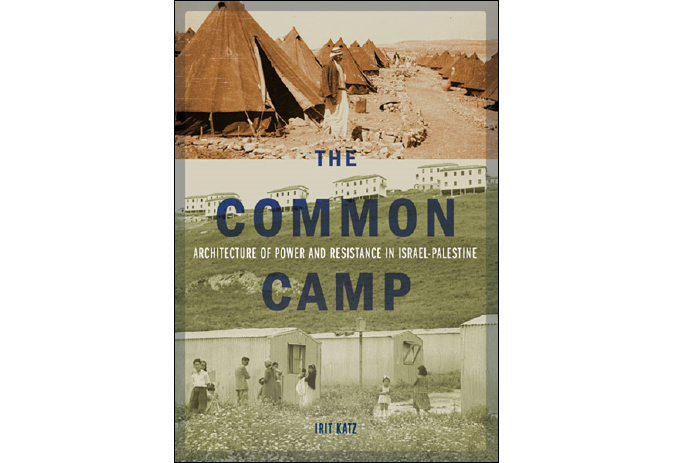Between 2013 and 2018, Israel operated a detention camp for African asylum seekers trafficked or smuggled across the Egyptian-Israeli border. Located in the Negev Desert and surrounded by military-held military area used for fire drills, the 185-acre Holot camp was designed to house eleven thousand refugees fleeing Eritrea and Sudan who had begun arriving in Israel in 2006 and to encourage their ‘voluntary’ departure from the country. In her meticulous study The Common Camp: Architecture of Power and Resistance in Israel-Palestine, Irit Katz argues that the Holot camp was the counterpart to the ‘black city’ of Southern Tel Aviv, where thousands of asylum seekers founded a thriving cultural hub, in the way it was designed, constructed, and operated. Katz positions the camp as a territorial instrument for controlling and managing populations vis-à-vis the city. While Holot is seemingly a distinct, unique case, unrelated to the book’s focus on the ‘architecture of power and resistance in Israel-Palestine,’ Katz convincingly argues that the camp is a key spatial instrument in the architectural history of Israel–Palestine that started with Mandatory Palestine.
Katz’s book, the result of twenty years of in-depth research, partially published in journal articles in City, Political Geography, and the Journal of Architecture, provides a brilliant account of the role of the camp in the materialization of settlement ideology in Israel–Palestine over several historical periods. As the title suggests, the book analyses diverse aspects of the history of camps in Israel–Palestine, treating the camp as a cultural-political institution used by a variety of actors for controlling and resisting control.
The book’s seven chapters can be grouped into three sections. The first chapter, “The Camp Reconfigured,” positions the book’s historical inquiry within the rich theoretical framework that represents the camp as a key instrument for the violent control of populations by various regimes in modernity, laying the groundwork for the introduction of archival research in the following chapters.
In chapters 2 to 6, Katz explores early camps and highlights transformations in their political aims, spatial premises, and actors over a long historical period while refraining from clearly marking the scope of her historical inquiry. These chapters address the relationship between British colonialism and Zionist nationalism (chapter 2), the management of refugee and immigrant populations (chapter 3), citizenship and social roles in border camps (chapter 4), temporality, nomadism, and encampment as territorial tools (chapter 5), and camps as modes of identity and resistance (chapter 6).
Chapter 7, centers on the Holot detention camp. It takes a step back from the book’s focus on the role of the camp in shaping the violent negotiations over Israel–Palestine to argue for the universal stakes of camp architecture, forming a complement to the book’s first chapter.
The book’s beautifully researched chapters highlight the details and specificities of camp architecture in each historical period, offering an analysis of various actors, decision-making processes, design, construction, habitation, and multi-actor conflicts. Its main contribution is its presentation of a full picture that is based many layers of historical and analytical study. In other words, The Common Camp’s main argument — nuanced yet explicit — is that camp architecture characterizes the architectural history of all sectors in Israel–Palestine, and in this way, it makes an important theoretical contribution to the conceptual framework of the camp.
Katz’s work looks at the subject of Israel–Palestine from the perspective of conflict, orientalist gazes and modernization, colonization, ethnicity, gender, and the trauma of the Holocaust. Moreover, the book provides an account of the spatial history of Israel-Palestine through the lens of an architectural history of a political apparatus used to control populations, a history that also documents the various subversions and inversions of this apparatus by different actors over time. Unpacking these liminal, provisional, and temporary landscapes, Katz chooses the camp as the object of inquiry and adopts it as a site through which the plurality of other narratives can be addressed.
The book refers to the territorial geography as ‘Israel–Palestine’, thereby signaling its affiliation with a scholarly position that rejects the mainstream distinction between Israel and Palestine as two parallel historical narratives. It demonstrates how the two histories are inseparably intertwined over the historical period the book covers.
By discussing camp architecture across established political affiliations, Katz offers a novel entry point into the Israeli–Palestinian conflict, going against the grain of mainstream historiography, which insists that the two political projects of Zionism and Palestinian nationalism produce opposing regimes of control and subordination. She argues that the study of the camp as spatial instrument points to unchangingly shared histories, reveals the meddling of spatial identities with political ones, shows how actors resist camps and construct them, all of which suggests that the national project itself is as one of ‘camping, decamping, encamping,’ as the title of chapter 6 puts it. The study thus seems particularly significant in the light of ever-entangled spatiality in Israel–Palestine.
Competing Interests
The author has no competing interests to declare.
